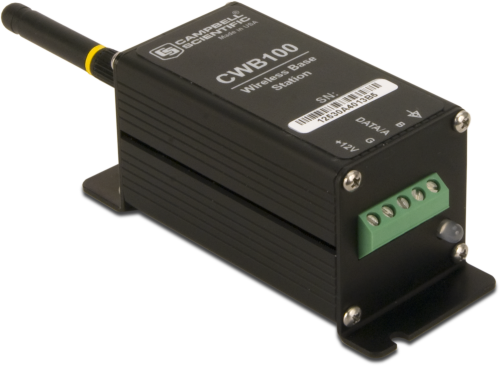This product is not available for new orders.

| Services Available | |
|---|---|
| Repair | No |
| Calibration | No |
| Free Support | Yes |
概览
CWB100为Campbell Scientific无线传感器网络中的主电台,可从多达50个无线传感器问询并存储数据,然后将数据传送到数据采集器上。CWB100的内部电台频段为902 至 918 MHz,是用于美国和加拿大的合法频段。
优势与特点
- 内部跳频的射频电台提供了更长的通讯距离和更少的干扰
- 从多达50个无线传感器问询和储存数据
- 可设置适合您的应用
图像







技术说明
使用A205型号的CWS到PC的接口,和Campbell Scientific的无线传感器规划程序、网络规划程序或设备配置实用工具软件,来配置WB100基站。数据采集器经编程后,连接CWB100并确认问询间隔。在收到问询间隔后,CWB100基站使用该信息,在被数据采集问询数据之前,向无线传感器问询数据。
为什么选择无线传感器?
在那些使用有线传感器会产生一些问题的站点,继续使用有线方式会有一些问题。首先,为了保护线缆,需要穿管、挖沟,既费时又费力,有些时候甚至没有可能性。当地的防火规范可能会禁止建筑内部使用某些类型的线缆。在某些应用中,测量需要通过较长距离实现,而较长的线缆可能会降低测量质量,或者成本太高。还有些时候,增加测量的数目非常重要,而数据采集器又没有留有足够的通道用于接入额外的传感器线缆。
产品规格
| Power Source | Data logger |
| Voltage | 4.5 to 22 Vdc |
| Operating Temperature Range | -25° to +50°C |
| Operating Relative Humidity Range | 0 to 100% |
| Standby Typical Current Drain | < 1 mA (@ 12 Vdc) |
| Receive Typical Current Drain | 10 mA (@ 12 Vdc) |
| Transmit Typical Current Drain | 20 mA (@ 12 Vdc) |
| Communication | Serial protocol or USB |
| Terminal Block Connector | Bi-directional serial data logger connection |
| USB Port | Computer connection for configuration |
| Antenna Connector | RPSMA antenna connection |
| Memory Capacity | Can store data table for up to 50 wireless sensors. |
| Dimensions | 10.8 x 4.4 x 4.4 cm (4.25 x 1.75 x 1.75 in.) |
| Weight | 140 g (5 oz) |
Internal 25 mW FHSS Radio |
|
| Frequency | 902 to 918 MHz |
| Where Used | US and Canada |
| FHSS Channel | 50 |
| Transmitter Power Output | 25 mW (+14 dBm) |
| Receiver Sensitivity | -110 dBm (0.1% frame error rate) |
| Standby Typical Current Drain | 3 μA |
| Receive Typical Current Drain | 18 mA (full run) |
| Transmit Typical Current Drain | 45 mA |
| Average Operating Current | 15 μA (with 1-second access time) |
| Quality of Service Management | RSSI |
| Additional Features | GFSK modulation, data interleaving, forward error correction, data scrambling, RSSI reporting |
兼容性
Please note: The following shows notable compatibility information. It is not a comprehensive list of all compatible products.
数据采集器
| Product | Compatible | Note |
|---|---|---|
| CR200X (retired) | ||
| CR206X (retired) | ||
| CR211X (retired) | ||
| CR216X (retired) | ||
| CR295X (retired) | ||
| CR3000 (retired) | The CR3000 datalogger must have data logger OS version 21 or higher. | |
| CR6 | The CR6 datalogger must have data logger OS version 4.0 or higher. | |
| CR800 (retired) | The CR800 datalogger must have data logger OS version 21 or higher. | |
| CR850 (retired) | The CR850 datalogger must have data logger OS version 21 or higher. |
Additional Compatibility Information
Data Logger Considerations
The data logger is programmed to interface with the CWB100 and determine a polling interval. The sensors make their measurements as they are polled. The base station polls all sensors and stores the collected data early enough that it can transfer the data as soon as the data logger requests it. This minimizes the amount of time the data logger needs to wait for a response from the network through the CWB100 base station.
At the start of each polling interval, the data logger polls the base station, and sensor values are transferred to the data logger for storage. This method of data transfer from the sensors to the data logger provides the fastest and lowest power method available.
下载
CWB100 USB Driver () 01-01-2014
Windows USB drivers for the CWB100 are installed via the Device Configuration Utililty. In the Device Configuration Utility, click on the link "install the device driver for the CWB100" in the main body of text for the CWB100.
Note: Driver must be installed before connecting the CWB100 to your computer.
Wireless Sensor Planner v.1.7 (30.5 MB) 08-08-2013
The Wireless Sensor Planner is a tool for use with Campbell Scientific wireless sensors. It assists in designing and configuring wireless sensor networks.
常见问题解答
CWB100: 3
展开全部收起全部
-
The SDI-38 communications protocol between the data logger and CWB100 is proprietary to Campbell Scientific. Contact support@campbellsci.com for more information.
-
Only one CWB100 can be connected to each odd channel control port. For the CR800 and CR850, this relates to two total units—one on C1 and one on C3. On the CR1000 and CR3000, this amounts to four total units.
Putting more than one CWB100 on a data logger will NOT speed up sensor data collection. Only one CWB100 should be accessed at any given time, or the devices will interfere with each other. If multiple CWB100 devices are connected to a single data logger, the data collection schedules for the CWB100 devices should be staggered. Sufficient time should be built in to allow each base unit to collect data from all of the remote sensors associated with it and to allow for any needed retries.
-
Because the devices and the radios use the same frequency bands, there will be interference. Factors affecting the amount of interference include the distances between the communications radio and the CWS radios, and the distances between the CWS base and the sensors. Also, the amount of interference is affected by whether the communications radio is set up as a master.

